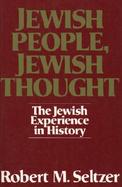Jewish People, Jewish Thought
- List Price: $188.40
- Binding: Paperback
- Edition: 1
- Publisher: Pearson
- Publish date: 11/01/1981
Description:
I. THE ANCIENT NEAR EASTERN PERIOD. 1. The History of Israel from Its Origins to the Sixth Century BCE. 2. The Biblical Heritage: Narratives, Law, and Pre-Exilic Prophecy. 3. The Biblical Heritage: Later Developments and Other Streams of Thought. II. FROM THE HELLENISTIC PERIOD TO LATE ANTIQUITY. 4. The Hellenistic Diaspora and the Judean Commonwealth to 70 CE. 5. Varieties of Judaism in the Late Second Temple Period. 6. The Efflorescence of Rabbinic Judaism, Second to Seventh Centuries. III. MIDDLE AGES AND EARLY MODERN TIMES. 7. Medieval Jewry to 1500. 8. Medieval Jewish Theology and Philosophy. 9. Medieval Jewish Mysticism and Kabbalah. 10. Jews and Judaism in the Early Modern Period. IV. THE MODERN PERIOD. 11. The European State and the Jews, 1770-1880. 12. First Encounters with Modern Thought, from Spinoza to Krochmal. 13. The Questions of Jewish Religious Reform in Nineteenth-Century Germany. 14. The Onslaught of Modernity: Jewish History from 1880 to the Present. 15. Secular Jewish Thought in the Nineteenth and Twentieth Centuries. 16. Twentieth-Century Jewish Religious Thought. Notes. Suggestions for Further Reading. Index.
Expand description
Product notice
Returnable at the third party seller's discretion and may come without consumable supplements like access codes, CD's, or workbooks.
| Seller | Condition | Comments | Price |
|
bookruns
|
Good
|
$3.98
|
|
BookReadingInc
|
Acceptable
|
$12.85
|
|
BookReadingInc
|
Good
|
$13.53
|
|
Orion Tech
|
Acceptable |
$2.98
|
|
Solr Books
|
Very Good
|
$5.20
|
|
BooksRun
|
Good
|
$7.01
|
|
readmybooks
|
Acceptable |
$12.94
|
|
readmybooks
|
Good |
$13.39
|
|
Book Dispensary
|
Very Good
|
$22.50
|
|
TEXTBOOKHUT
|
Good |
$34.62
|
|
TEXTSHUB
|
Good
|
$36.17
|
|
BOOKWORDS
|
Good |
$48.32
|
|
Book Words
|
Good
|
$51.56
|
|
BOOKWORDS
|
Very Good |
$56.86
|
|
Book Words
|
Very Good
|
$60.62
|
|
TEXTBOOKHUT
|
New |
$78.16
|
|
TEXTSHUB
|
New
|
$83.35
|
|
GridFreed
|
New |
$102.66
|

Please Wait

